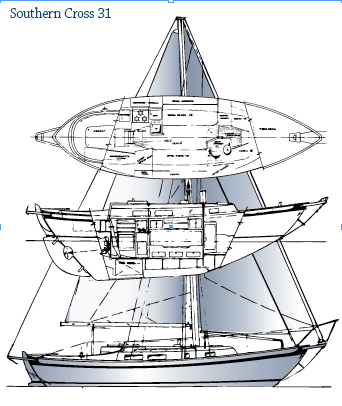Southern Cross 31, Originally reviewed October 1975
Cutter

In the early 1970s, the world of offshore cruising boats was dominated by double-ended types reflecting the designs of William Atkin. Atkin's double-enders were Americanizations of the Scottish designer Colin Archer's work in offshore lifeboats in Europe. The most famous of these American varieties is of course the Westsail 32, based on an early Atkin design, Eric. The general agreement at the time was that the best bluewater boats were double-enders with full keels.
The Southern Cross 31 designed by Tom Gilmer is a good example of the type.
Gilmer was a great designer. He had the eye. In a nutshell that's why I chose this design. It's a very good-looking boat with shapely ends and a nicely balanced and springy sheer. Gilmer took the Colin Archer type and flattened the buttocks, firmed up the bilges to add initial stability and added volume in the ends. The idea was to improve boat speed and reduce the Archer/Atkin type's tendency to hobbyhorse. Gilmer kept the trademark outboard rudder, an essential part of this aesthetic. The full keel is pulled back from the bow slightly but it still is a true full keel with a hefty D/L of 388 and a L/B of 3.26.
Keep in mind when you look at a design like Southern Cross that this was a time when "speed" was not a word associated with offshore cruising boats. There was a huge performance gap between the offshore boat of the day and the latest IOR "freak." The IOR boats were fast but they were considered dangerous by cruisers and not fit for offshore work. Heck, the IOR boats had fin keels and spade or skeg-hung rudders. That would never do. Of course, my Valiant 40 design changed that. It was essentially a hybrid design that bridged the gap between racers and cruisers. Someone called it a "performance-cruiser" and the term stuck. I remember an angry John Neale coming to my office with a "how dare you" attitude. John sails a nice Halberg-Rassy today with a spade rudder and fin keel. Times change.
At the beginning of the 1970s the ketch rig was considered the ultimate for most bluewater boats. But the cutter rig soon replaced the ketch as the standard rig for offshore work. The Southern Cross shows a well-proportioned cutter rig with a short, plank type bowsprit and a boomkin off the stern to get the backstay clear of the outboard rudder. It's not a big rig. The SA/D is only 12.57, so it would be very slow going in light air.
The interior layout is as simple as it could be and near perfect to my eye today. For pure functionality it's hard to beat these old orthogonal layouts.
They don't make them like this anymore but we sure made a lot of them like this back in the 1970s and 1980s.
Read the original review at: http://www.sailingmagazine.net/boats/3-perry-on-design/1096-southern-cross
LOA 31; LWL 25; Beam 9'6"; Draft 4'7"; Displacement 13,6000 lbs.; Ballast 4,100 lbs.; Sail area 496
Original sailaway price $54,900

Comments